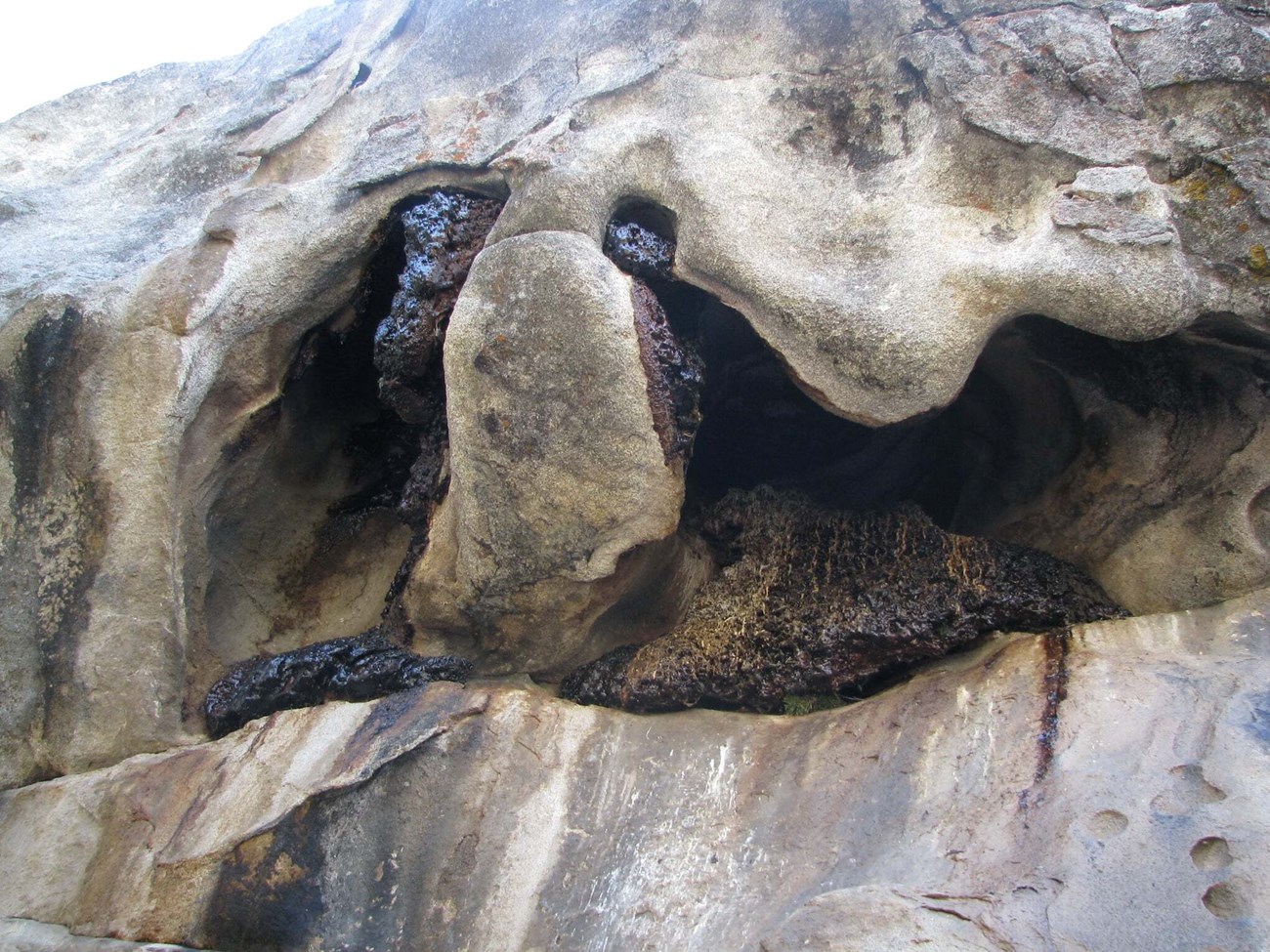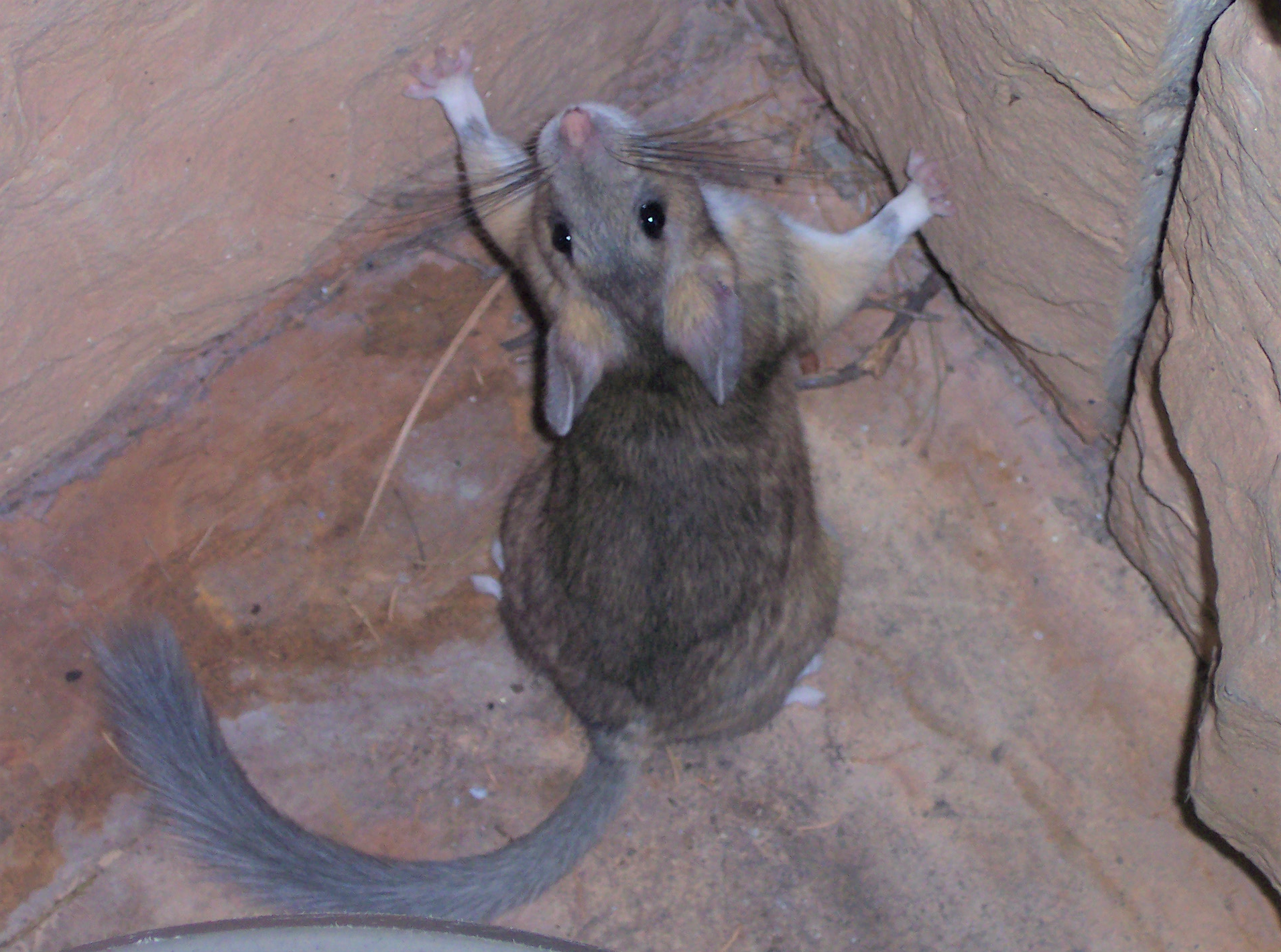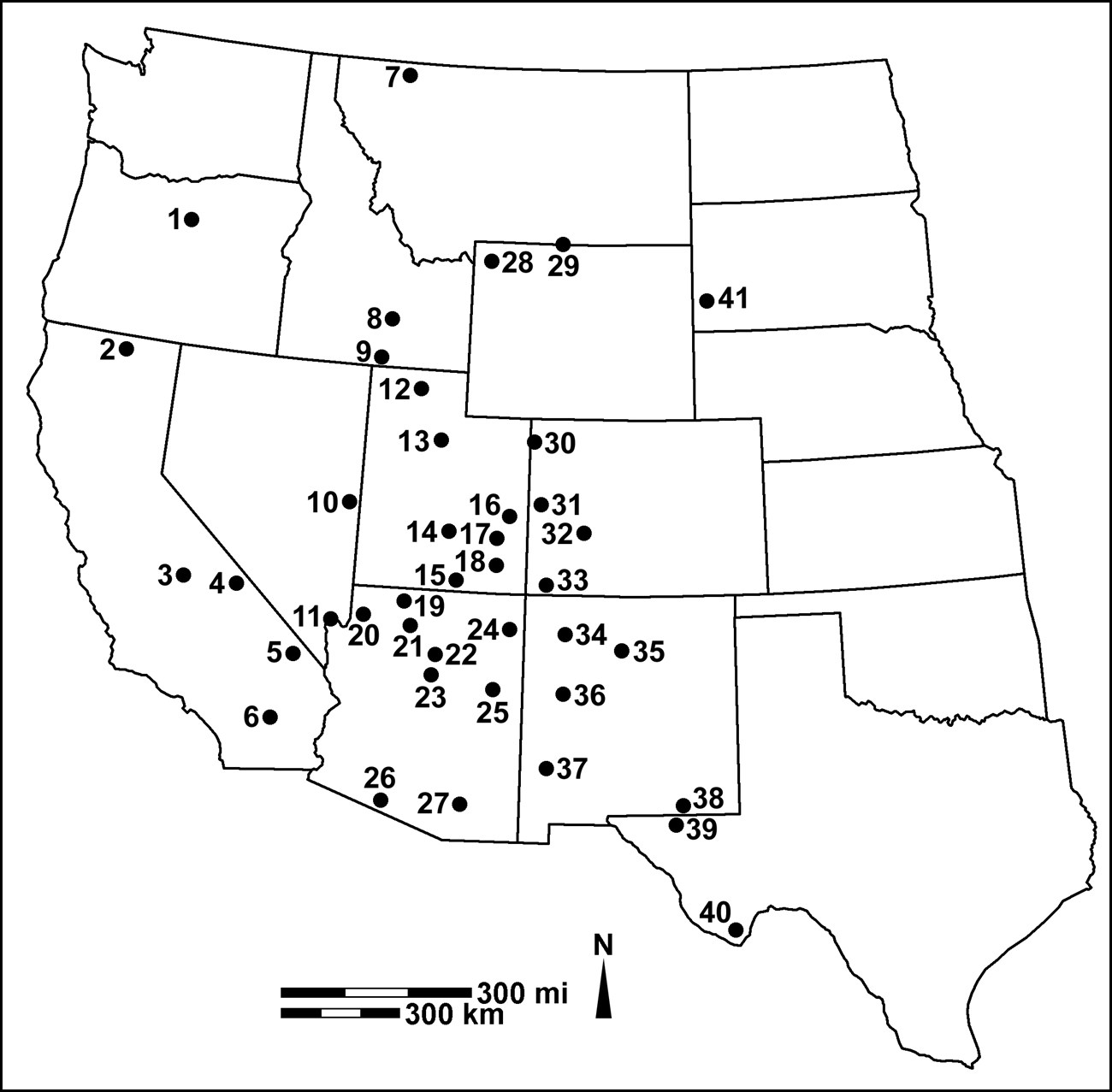Part of a series of articles titled Park Paleontology News - Vol. 14, No. 2, Fall 2022.
Article
Studying the Past and Predicting the Future Using Rat Nests

Justin Tweet, NPS Partner—Paleontologist
American Geosciences Institute

NPS photo.
Introduction
Imagine you wanted to study the recent past of an area, to learn about the plant and animal communities that flourished there a thousand, or ten thousand, or twenty thousand years ago. What kinds of fossils would you look at? When people think about fossils, they often think first of big vertebrate animals, like dinosaurs and mammoths, but big vertebrates do not tell as much about their surroundings as other fossils. Big animals are relatively rare in an environment and usually not strongly restricted by environmental factors; they got big by eating a lot and cannot be too picky. Instead, the best fossils for answering these kinds of question are much farther down the food chain: pollen, leaves, invertebrates, and small vertebrates. These fossils are even more useful if found in some kind of setting that accumulated fossils over hundreds or thousands of years. Some of the best places to find fossils like these are lakes and bogs, where scientists can take cores of sediment many feet long covering tens of thousands of years. What do you do, though, if you’re in an area without many lakes, such as Arches National Park or Death Valley National Park in the dry Southwest? It turns out that there is another source of these kinds of fossils: packrat middens.

NPS photo.
Packrat Middens
Packrats, also known as woodrats, belong to the genus Neotoma. They look similar to common brown rats, with the most obvious differences being their furry tails and large ears. Many species are found throughout North America, with differing environmental preferences. Packrats are solitary and territorial, foraging in a territory with a radius of about 100 to 160 feet. They build large dens or nests within their territories using pieces of plants and other objects they find, preferring to build in caves or rock shelters. They also collect objects that are interesting to them, so recent dens may include human artifacts. Part of the den is used as an outhouse and dump for surplus food and construction material; this accumulation of debris is called a midden.
Middens may be loose and unconsolidated, or hardened into a dark, glossy material thanks to the properties of packrat urine. In dry settings, over time packrat urine crystallizes into a material called “amberat” that can protect and preserve materials saturated with it for tens of thousands of years, as long as it does not rehydrate. Across the West there are countless ancient middens that act as accidental time capsules, holding plant fragments, pollen, insects and other invertebrates, small bones, fur, and packrat droppings. (There are also accumulations of materials in eastern states that are thought to be ancient middens, but the preservation is not as good because the greater humidity prevents the formation of amberat.) Through careful study of these middens we can build detailed pictures of past settings and climates.

NPS photo by Justin Tweet.
Layers of Information
Packrat middens can be used to study an astonishing variety of questions. Although individual rats do not live many years, dens in prime locations will be reused, so records of activity in a single small area can build up over hundreds to thousands of years, with layers in the midden deposit representing individual middens. Studying the midden layers can show when individual types of organisms and larger communities appeared or disappeared from an area. Most studies have focused on plants using body fossil fragments, but any kind of fossil found in a midden can be studied the same way, from millipedes to lizard scutes to packrat droppings.
In the National Park Service, middens have been used to study everything from the rate of erosion in the Grand Canyon, to the extinction of ground sloths, to the timing of when people abandoned Chaco Canyon. At Death Valley National Park, researchers have studied changes in rat dropping size over time as a way of looking at climate change: over time a large, heat-intolerant species has been replaced by a smaller, heat-tolerant species. A species of extinct plant, the rabbitbrush Chrysothamnus pulchelloides, has been named from material found in a Chaco midden. One of their important uses for park management is providing a record of past ecosystems. This can be useful for restoring areas to pre-disturbance conditions or predicting how existing ecosystems will respond to climate changes based on how they responded in the past.

NPS photo by Justin Tweet.
Park Units with Packrat Middens
Fossil and recent packrat middens have been found at many NPS units in western states. They have been reported from 41 different park units and are probably present in others. Some of them are more than 50,000 years old (the practical limit of radiocarbon dating), but most of them are younger, from around 30,000 years old to the present. Each one is a unique capsule of biological information that can be used to describe the past and project the future. If you are hiking in areas of western parks where there are canyons, rock shelters, alcoves, and similar features, you may spot active or ancient middens. Unconsolidated middens look like piles of plant fragments and rodent droppings, whereas ancient hardened middens have a dark glossy appearance, with embedded fossils. If you see one, you should tell park staff, but remember to leave it alone, not only because it is a fossil, but also because it is unsanitary! If you’re interested in learning more about packrat middens, the U.S. Geological Survey and National Oceanic and Atmospheric Administration maintain a searchable online database at USGS/NOAA—North American Packrat Midden Database.

NPS units with ancient or modern packrat middens. 1. John Day Fossil Beds NM; 2. Lava Beds NM; 3. Sequoia and Kings Canyon NP; 4. Death Valley NP; 5. Mojave NPres; 6. Joshua Tree NP; 7. Glacier NP; 8. Craters of the Moon NM and Preserve; 9. City of Rocks NPres; 10. Great Basin NP; 11. Lake Mead NRA; 12. Golden Spike NHS; 13. Timpanogos Cave NM; 14. Capitol Reef NP; 15. Glen Canyon NRA; 16. Arches NP; 17. Canyonlands NP; 18. Natural Bridges NM; 19. Pipe Spring NM; 20. Grand Canyon-Parashant NM; 21. Grand Canyon NP; 22. Wupatki NM; 23. Walnut Canyon NM; 24. Canyon de Chelly NM; 25. Petrified Forest NP; 26. Organ Pipe Cactus NM; 27. Saguaro NP; 28. Yellowstone NP; 29. Bighorn Canyon NRA; 30. Dinosaur NM; 31. Colorado NM; 32. Curecanti NRA (equivocal); 33. Mesa Verde NP; 34. Chaco Culture NHP; 35. Bandelier NM; 36. El Malpais NM; 37. Gila Cliff Dwellings NM; 38. Carlsbad Caverns NP; 39. Guadalupe Mountains NP; 40. Big Bend NP; 41. Jewel Cave NM.
NPS image by Justin Tweet.
Featured Parks
-
Arches National Park, Utah—[Geodiversity Atlas] [Park Home] [npshistory.com]
-
Bandelier National Monument, New Mexico—[Geodiversity Atlas] [Park Home] [npshistory.com]
-
Big Bend National Park, Texas—[Geodiversity Atlas] [Park Home] [npshistory.com]
-
Bighorn Canyon National Recreation Area, Montana and Wyoming—[Geodiversity Atlas] [Park Home] [npshistory.com]
-
Canyon de Chelly National Monument, Arizona—[Geodiversity Atlas] [Park Home] [npshistory.com]
-
Canyonlands National Park, Utah—[Geodiversity Atlas] [Park Home] [npshistory.com]
-
Capitol Reef National Park, Utah—[Geodiversity Atlas] [Park Home] [npshistory.com]
-
Carlsbad Caverns National Park, New Mexico—[Geodiversity Atlas] [Park Home] [npshistory.com]
-
Chaco Culture National Historical Park, New Mexico—[Geodiversity Atlas] [Park Home] [npshistory.com]
-
City of Rocks National Reserve, Idaho—[Geodiversity Atlas] [Park Home] [npshistory.com]
-
Colorado National Monument, Colorado—[Geodiversity Atlas] [Park Home] [npshistory.com]
-
Craters of the Moon National Monument and Preserve, Idaho—[Geodiversity Atlas] [Park Home] [npshistory.com]
-
Curecanti National Recreation Area, Colorado—[Geodiversity Atlas] [Park Home] [npshistory.com]
-
Death Valley National Park, California and Nevada—[Geodiversity Atlas] [Park Home] [npshistory.com]
-
Dinosaur National Monument, Colorado and Utah—[Geodiversity Atlas] [Park Home] [npshistory.com]
-
El Malpais National Monument, New Mexico—[Geodiversity Atlas] [Park Home] [npshistory.com]
-
Gila Cliff Dwellings National Monument, New Mexico—[Geodiversity Atlas] [Park Home] [npshistory.com]
-
Glacier National Park, Montana—[Geodiversity Atlas] [Park Home] [npshistory.com]
-
Glen Canyon National Recreation Area, Arizona and Utah—[Geodiversity Atlas] [Park Home] [npshistory.com]
-
Golden Spike National Historic Site, Utah—[Geodiversity Atlas] [Park Home] [npshistory.com]
-
Grand Canyon National Park, Arizona—[Geodiversity Atlas] [Park Home] [npshistory.com]
-
Grand Canyon-Parashant National Monument, Arizona—[Geodiversity Atlas] [Park Home] [npshistory.com]
-
Great Basin National Park, Nevada—[Geodiversity Atlas] [Park Home] [npshistory.com]
-
Guadalupe Mountains National Park, Texas—[Geodiversity Atlas] [Park Home] [npshistory.com]
-
Jewel Cave National Monument, South Dakota—[Geodiversity Atlas] [Park Home] [npshistory.com]
-
John Day Fossil Beds National Monument, Oregon—[Geodiversity Atlas] [Park Home] [npshistory.com]
-
Joshua Tree National Park, California—[Geodiversity Atlas] [Park Home] [npshistory.com]
-
Lake Mead National Recreation Area, Arizona and Nevada—[Geodiversity Atlas] [Park Home] [npshistory.com]
-
Lava Beds National Monument, California—[Geodiversity Atlas] [Park Home] [npshistory.com]
-
Mesa Verde National Park, Colorado—[Geodiversity Atlas] [Park Home] [npshistory.com]
-
Mojave National Preserve, California—[Geodiversity Atlas] [Park Home] [npshistory.com]
-
Natural Bridges National Monument, Utah—[Geodiversity Atlas] [Park Home] [npshistory.com]
-
Organ Pipe Cactus National Monument, Arizona—[Geodiversity Atlas] [Park Home] [npshistory.com]
-
Petrified Forest National Park, Arizona—[Geodiversity Atlas] [Park Home] [npshistory.com]
-
Pipe Spring National Monument, Arizona—[Geodiversity Atlas] [Park Home] [npshistory.com]
-
Saguaro National Park, Arizona—[Geodiversity Atlas] [Park Home] [npshistory.com]
-
Sequoia and Kings Canyon National Park, California—[Geodiversity Atlas] [Park Home] [npshistory.com]
-
Timpanogos Cave National Monument, Utah—[Geodiversity Atlas] [Park Home] [npshistory.com]
-
Walnut Canyon National Monument, Arizona—[Geodiversity Atlas] [Park Home] [npshistory.com]
-
Wupatki National Monument, Arizona—[Geodiversity Atlas] [Park Home] [npshistory.com]
-
Yellowstone National Park, Wyoming—[Geodiversity Atlas] [Park Home] [npshistory.com]
Related Links
Tags
- arches national park
- bandelier national monument
- big bend national park
- bighorn canyon national recreation area
- canyon de chelly national monument
- canyonlands national park
- capitol reef national park
- carlsbad caverns national park
- chaco culture national historical park
- city of rocks national reserve
- colorado national monument
- craters of the moon national monument & preserve
- curecanti national recreation area
- death valley national park
- dinosaur national monument
- el malpais national monument
- gila cliff dwellings national monument
- glacier national park
- glen canyon national recreation area
- golden spike national historical park
- grand canyon national park
- grand canyon-parashant national monument
- great basin national park
- guadalupe mountains national park
- jewel cave national monument
- john day fossil beds national monument
- joshua tree national park
- lake mead national recreation area
- lava beds national monument
- mesa verde national park
- mojave national preserve
- natural bridges national monument
- organ pipe cactus national monument
- petrified forest national park
- pipe spring national monument
- saguaro national park
- sequoia & kings canyon national parks
- timpanogos cave national monument
- walnut canyon national monument
- wupatki national monument
- yellowstone national park
- park paleo news series
- fossils
- paleontology
- nature
- science
- geology
- jmrlc
- natural resources
Last updated: January 12, 2023
